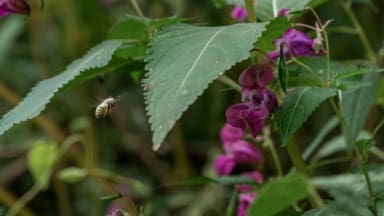
According to Defra, in Britain and Ireland, non-native plants now outnumber native plants in the wild. The removal of invasive plants from natural habitats, especially nature conservation sites is costly and difficult – where often complete eradication is impossible.
The impacts of invasive non-native plants
- Crowding out native plants – reducing biodiversity and affecting other species that rely on them for food or shelter.
- Spreading plant diseases such as Ramorum disease (Phytophthora ramorum and P. kernoviae) which can be carried by an invasive rhododendron (Rhododendron ponticum) and are a serious threat to native species including oak, beech and larch.
- Hybridising with native species until the native species and its unique characteristics no longer exist, for example the native bluebell, an iconic woodland species is threatened by the invasive Spanish bluebell
clogging waterbodies – reducing the availability of light and oxygen in the water, interfering with recreation, and increasing the flood risk. - Harming health such as for example, giant hogweed sap can cause blistering of the skin on exposure to sunlight
The Great Britain Non-native Species Secretariat (NNSS), responsible for coordinating the approach to invasive non-native species in Great Britain has set out a series of ambitious objectives to guide government departments, related bodies and key stakeholders to deliver an effective response to preventing, eradicating and managing invasive non-native species.
‘Be Plant Wise’ Campaign
Around 40% of the invasive non-native species that cause problems in Great Britain are likely to have been introduced through horticulture. The Be Plant Wise campaign by the NNSS aims to inform gardeners and retailers to prevent further spread of invasive plants.
Advice for gardeners
- Research plants prior to purchase – see NNSS booklet with guide to invasive plants and alternative options. Similarly, take care before giving or accepting cuttings to avoid helping the spread of invasive species, pests and/or plant diseases.
- Keeping plants in the garden and not to plant or allow them to grow in the wild. Even native plants can cause a problem if they are planted in the wrong place.
- Compost with care, making sure nothing that is removed from the garden or pond gets into the wild – to d so one runs the risk of breaking the law. Most plants can be put in the garden waste bin, but gardeners are reminded to check with their local council first. Plants such as Japanese knotweed have extra controls around their disposal. See the guidance as to plants that can’t be composted and how to dispose of them.
- Where invasive plants are found;
- Remove seeds (heads and pods), invasive runners and seedlings regularly
- Keep unfamiliar plants in areas where they can be managed and don’t run the risk of spreading into the wild
- Report invasive plants to the Plant Alert citizen science project. The data collected will help scientists identify which species are likely to become a problem in the wild in the future. For invasive plants spotted in the wild, they can be reported via iRecord.
Advice for retailers
Retailers have an important role to play in terms of the provision of plants and educating their customers.
There are a range of plants that are already banned from sale, and it is an offence to allow a number of the most invasive plants to grow in the wild. In Scotland it is an offence to allow any non-native plant to grow in the wild. Many invasive plants can still be legally sold, but should only be grown, managed and disposed of with caution to avoid environmental harm. For further information, see Restricted non-native plants and guidance on legislation around non-native species.
Retailers are also advised to:
- Ensure plants are labelled with full botanical name in addition to common name (if used)
- Assist customers to choose appropriate plants, depending on the size and purpose of their garden or pond.
- Ensure plants, water or soil being sold are checked to ensure free of contaminants
- Clean tools, equipment and footwear regularly, including any pots and trays to avoid spreading plant fragments, seeds or plant diseases.
- Report pests and diseases through the Plant Health Portal
Be Plant Wise plants information packs with communication materials are available to help spread the message.

